New Vs Worn Road Bike Tire: GP4000S II
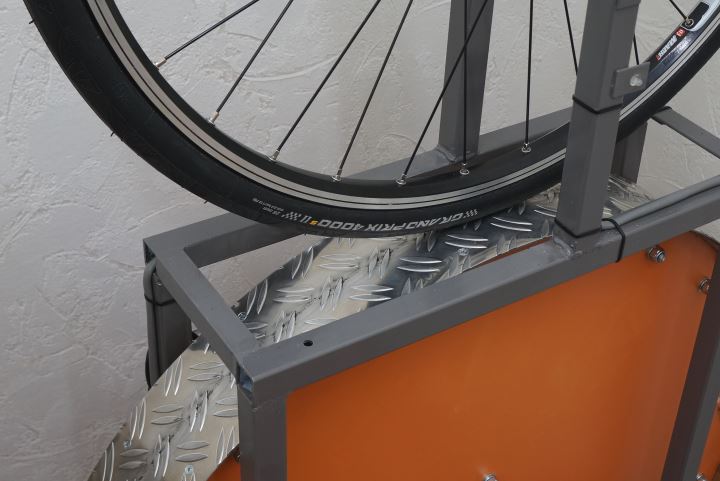
In this article, I'll be comparing a brand new 28 mm Grand Prix 4000S II to a pair of used 28 mm Grand Prix 4000S II tires that have been used for 5000 miles / 8000 km over a 2 year period. I've wanted to do an article like this for a long time as it will give us some insight into what to expect when it's time to retire your tires. These tires were sent in by a reader that wanted to know the difference between a new and a used tire as well. Thank you, Alek.
Even though this comparison is based on data obtained from a pair of Continental Grand Prix 4000S II road bike tires, it should be useful for other tires as well. As the Grand Prix 4000S II is by far the most popular road bike tire of the last couple of years, I feel these are the perfect tires for this comparison.
Tire Condition
The tires used for this test were used for a period of 2 years and have covered 5000 miles / 8000 km in Ireland. The tires were rotated a couple of times which has resulted in close to the same wear for both tires. The bike was stored in Alek's hall most of the time and a couple of hours per day outside of the office. Alek reckons UV and heat exposure in Ireland is minimal.
The reason for replacing this set of 28 mm GP4000S II's was not the tread that has worn out, but the casing that has started to give up in several places. The tires were run at 60/70 psi most of the time and have also seen some light gravel use which might have contributed to wearing out the casing. The tread still has a good thickness as I've measured them at 2.1 mm and 2.2 mm tread thickness. A brand new GP4000S II comes in somewhere between 2.6 and 2.9 mm tread thickness.
One other thing that strikes out when looking at these tires is the extreme cracking of the compound. I've asked Alek about this and he mentioned the cracking started a long time ago and he assumed this was normal for the Black Chili compound. He also mentioned this didn't seem to affect their performance and the tires had amazing grip until the end.
Pictures of Tire Condition
Because pictures tell a thousand words with things like this, here are some pictures that tell more about the condition of these tires. All pictures were taken with a tire pressure of 100 psi / 6.9 bars.
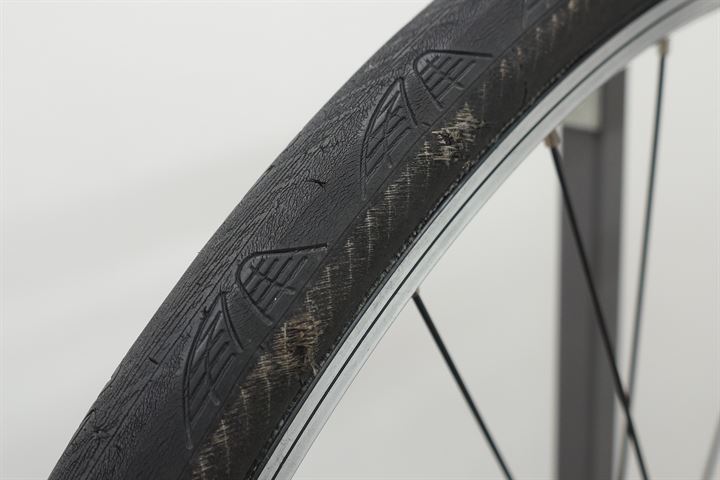
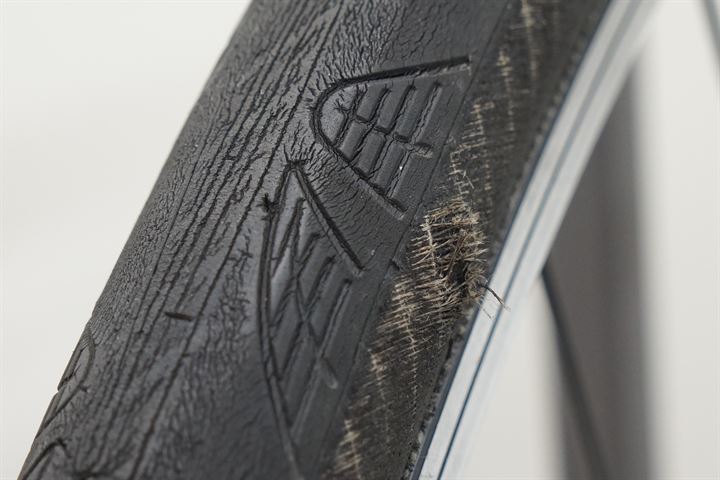
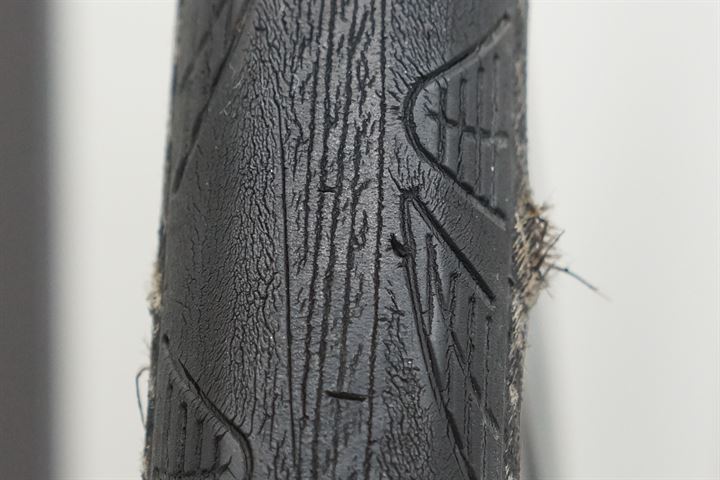
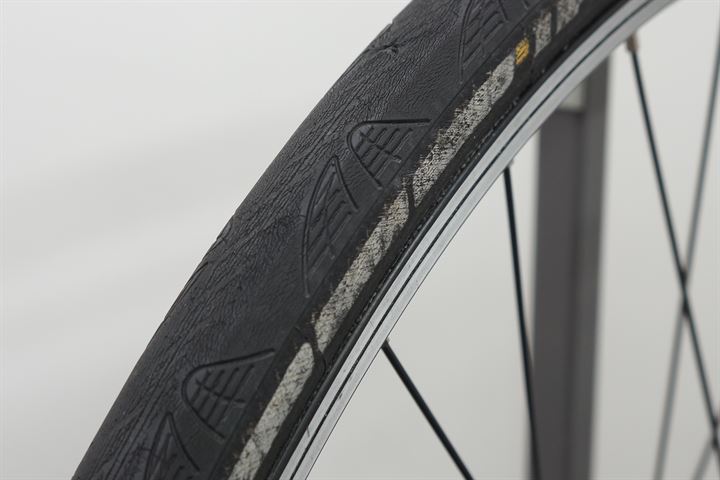
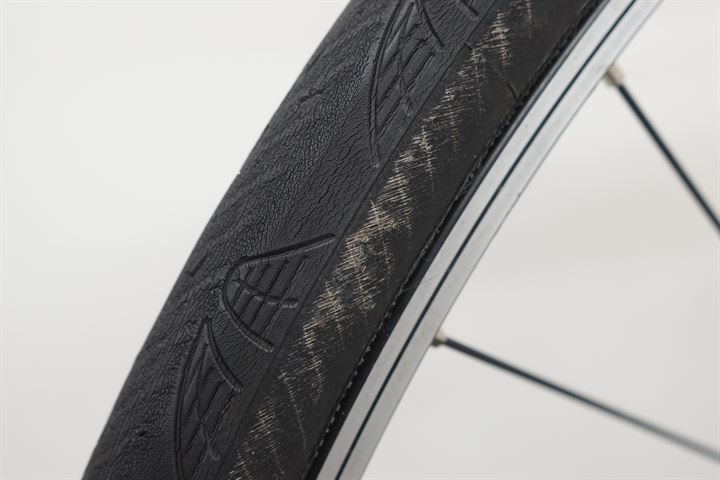
Test conditions
- Speed of 18 mph / 29 km/h
- Total wheel load of 94 lbs/ 42.5 kg
- 700 x 17C wheel
- Temperature between 21-23 °C / 70-73 °F
- 100 grams Continental Race 28 Inner Tube
To read about all other test conditions and how tires are tested, please read the Rolling Resistance Test Conditions Explained page.
Test Results
Weight and Thickness
| New GP4000S II | Worn Sample A | Worn Sample B | |
|---|---|---|---|
| Specified Weight | 260 grams | 260 grams | 260 grams |
| Measured Weight | 267 grams | 245 grams | 250 grams |
| Tread Thickness | 2.6 - 2.9 mm | 2.2 mm | 2.1 mm |
| Sidewall thickness | 0.55 mm | 0.55 mm | 0.55 mm |
Continental specifies the weight of a brand new 28 mm GP4000S II to be 260 grams. My new sample is a bit heavier at 267 grams. The worn sample A comes in at just 245 grams, the worn sample B comes in at 250 grams. I don't know how heavy the worn tires were when new, but 245-250 grams is about what I would have expected from a GP4000S II with 5000 miles / 8000 km on the clock.
As mentioned previously, after 5000 miles / 8000 km worn sample A and worn sample B have a total thickness at the center of the tire of 2.2 and 2.1 mm respectively. A brand new GP4000S II usually comes in somewhere between 2.6 and 2.9 mm thickness. I think it's pretty astounding that these tires have only worn by 0.6 - 0.8 mm after all these miles. I've cut one tire in half to see how much tread is left over and it appears there's still close to 1.0 mm worth of tread before the casing would start to show.
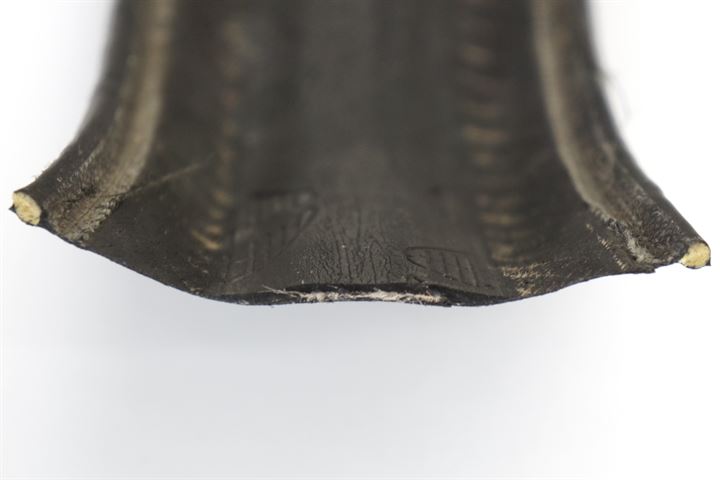
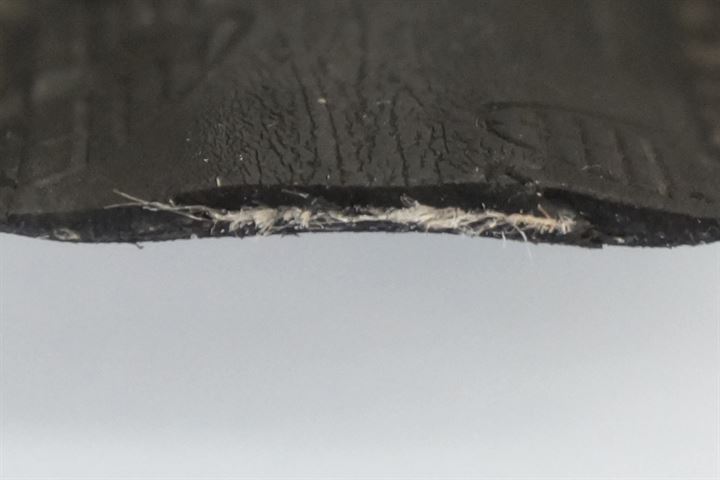
Rolling Resistance
| New GP4000S II | Worn Sample A | Worn Sample B | |
|---|---|---|---|
| Rolling Resistance 120 psi / 8.3 bars | 11.6 Watts CRR: .00347 |
11.9 Watts CRR: .00357 |
11.4 Watts CRR: .00342 |
| Rolling Resistance 100 psi / 6.9 Bar | 12.0 Watts CRR: .00360 |
12.4 Watts CRR: .00372 |
11.9 Watts CRR: .00357 |
| Rolling Resistance 80 psi / 5.5 Bar | 12.7 Watts CRR: .00381 |
13.2 Watts CRR: .00396 |
12.8 Watts CRR: .00384 |
| Rolling Resistance 60 psi / 4.1 Bar | 14.1 Watts CRR: .00423 |
15.0 Watts CRR: .00450 |
14.5 Watts CRR: .00435 |
When testing the rolling resistance of a tire that has less tread thickness than a brand new tire, we would expect rolling resistance to be lower. In practice, when a tire has been used and stored in varying circumstances, we also have to take the aging of the rubber compound into consideration. Wear of the Black Chili compound used on the GP4000S II is very low so other tires that show more tread wear after 5000 miles / 8000 km will perform slightly different here.
After testing both worn samples, we can see that at higher air pressures, rolling resistance is pretty much equal to the brand new GP4000S II. At lower air pressures, there seems to be a trend towards a slightly worse performance of the worn samples. This seems to make sense as at lower air pressures, the tread will deform more and the aged rubber will have lost some of its characteristics. At higher air pressures there will be less deformation and the thinner tread will offset the lost performance of the compound.
Puncture Resistance
| New GP4000S II | Worn Sample A | Worn Sample B | |
|---|---|---|---|
| Puncture Resistance Tread | 11 Points | 9 Points | 9 Points |
| Puncture Resistance Sidewall | 5 Points | 5 Points | 5 Points |
Another interesting test is the puncture resistance of a worn tire when compared to the brand new version. When looking at the numbers from the puncture tests, we can safely conclude that puncture resistance of the tread goes down when the tread gets thinner. There doesn't seem to be any positive influence from the aging of the compound here. Because the Black Chili compound shows just 0.6 - 0.8 mm of wear, the tread puncture test is still reasonable, worn tires that start to show the casing will perform terrible here.
The sidewalls don't seem to be affected by the cracking of the casing as the sidewall puncture scores are still equal to the brand new tire.
Conclusion
Rolling resistance of a worn tire is not lower than rolling resistance of a brand new tire when the tire has been used for general use (at least a GP4000S II). The tires used for this test were mounted to a bike that has seen all kind of weather conditions and has been stored outside during office hours. The results might be slightly better for tires that have been stored in a cool basement and are only taken out on the weekends.
The final conclusion is that you don't have to be worried about slower rolling tires when replacing your worn out tires with new tires as the differences will be minimal at best. The good part will be that puncture resistance will be restored, offsetting any tiny rolling resistance advantage you might have gained from worn tires.
